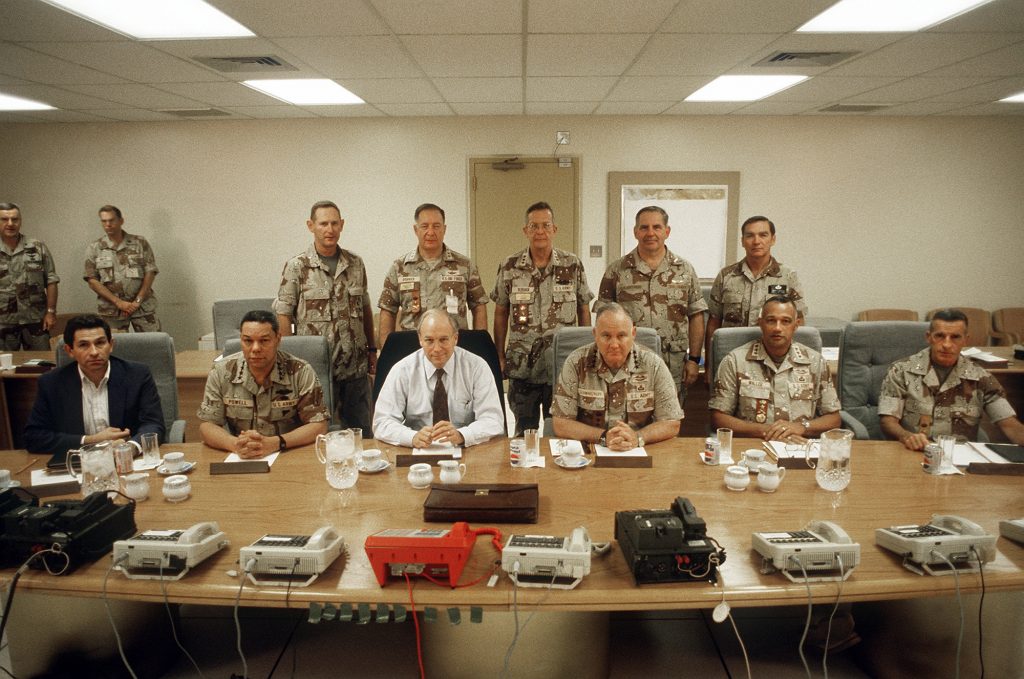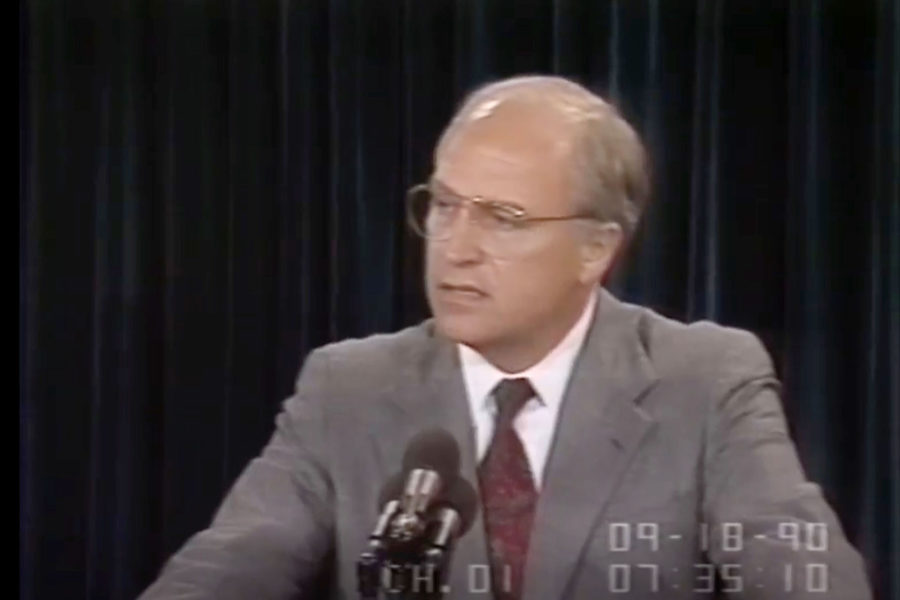Dick Cheney, who died Nov. 3 at 84, is best remembered by most Americans as among the most powerful Vice Presidents in history, a consummate Washington insider who had previously served in the Nixon administration, was Chief of Staff for President Gerald Ford, a Congressman for a decade, and Secretary of Defense for President George H.W. Bush.
It was as Defense Secretary from 1989-1993 that Cheney left a lasting thumbprint on the U.S. Air Force.
In September 1990, following Iraq’s invasion of Kuwait that summer and in the midst of the biggest U.S. military buildup since Vietnam, Cheney fired Air Force Chief of Staff Gen. Mike Dugan, backing Chairman of the Joint Chiefs Gen. Colin Powell, who took offense at a Washington Post news report in which Dugan had outlined how airpower could be used against Saddam Hussein’s Iraqi army.
Cheney also led the Pentagon through an extraordinary period at the end of the Cold War in which U.S. forces demonstrated unprecedented overmatch against one of the world’s biggest, most battle-experienced armies, and then began to dismantle itself in the historic post-Cold War drawdown.
Cheney clashed early in his tenure with Dugan’s predecessor as Chief of Staff, Gen. Larry D. Welch, after Welch engaged with Congress over whether to proceed with rail-based intercontinental ballistic missiles and a new road-mobile “Midgetman” ICBM.
The Secretary made clear his thinking in a UPI report at the time: “I think it’s inappropriate for a uniformed officer to be in a position where he is, in fact, negotiating an arrangement. I will have the opportunity to discuss it with him. I will make known to him my displeasure.”
The incident rattled Welch at the time, according to an officer familiar with the event, but the hand-slap hinted only of things to come. Welch retired as planned that July, and it was his successor, Dugan, who felt the ultimate sting. On the job just 78 days, Dugan’s tenure as Chief was the shortest in history.
Flying with reporters back from a visit to Airmen setting up shop for Desert Storm, Dugan told them airstrikes would be central to the effort, that the U.S. could target Iraqi President Saddam Hussein and his family, and that American public support would hold only until “the body bags come home.”
Powell, whose role as Chairman made him the President’s principal military advisor, saw the comments as impinging on his role. He complained to Cheney, and Cheney summoned Dugan to his Pentagon office and asked him to resign. Dugan asked to retire, and was replaced by Gen. Merrill McPeak.
Cheney explained his decision to reporters, calling Dugan’s comments sufficient cause for dismissal on several fronts: “We never talk about future operations, such as the selection of specific targets for potential airstrikes,” he said at the time. “We never talk about the targeting of specific individuals who are officials of other governments. Taking such action might be a violation of the standing presidential executive order. … In a situation involving potential conflict, I think it’s contrary to sound practice to reveal classified information about the size and disposition of U.S. forces. And as a general matter of policy, I don’t think we want to be demeaning the contributions of other services. General Dugan’s statements in my opinion were not consistent with this policy.”
Nevertheless, airstrikes did become the defining feature of Operation Desert Storm, the campaign to expel Iraq from Kuwait in 1991.

After months of buildup, U.S. and allied forces launched a six-week air campaign that became an international sensation, the first-ever applications of stealth, precision-guided munitions and space support on an operational scale.
The Air Force also introduced the concepts of “parallel warfare”—in which numerous targets were destroyed simultaneously, rather than in sequence—and “effects-based operations,” which focused first on the desired effects of strikes rather than the platform or weapons employed, before assigning forces to campaign tasks.
The air war that was so overwhelming that the entire ground campaign was over in just 100 hours, cementing the importance of airpower in modern warfare. Cheney approved of the airpower-heavy approach, and President Bush later said “lesson one” from the conflict was “the value of airpower.”
Cutbacks
After the successful war with Iraq, however, Cheney’s and Powell’s focus returned to the reshaping of the American military for a post-Cold War world. With the fall of the Berlin Wall and dissolution of the Soviet Union, they next presided over a historic drawdown of the U.S. military forces, seeking a so-called “peace dividend” for the world’s sole remaining superpower.
The future of airpower was also very much on Cheney’s agenda. In 1990, Cheney had led a Major Aircraft Review of the Navy’s A-12 attack plane, the Air Force’s Advanced Tactical Fighter, and two other critical programs, the B-2 stealth bomber and the C-17 airlifter. Cheney ordered a series of cuts: the C-17 would be cut from 210 to 120 aircraft (a cut that would ultimately be reversed) and the B-2 program from 132 aircraft to 75, a figure that was then slashed to just 21 airframes two years later.
Cheney reaffirmed the Air Force’s need for an Advanced Tactical Fighter, which would later be called the F-22, but in a decision with dire consequences, he decided to defer production two years, reducing the peak production rate of the aircraft and setting the stage years later to build a fraction of the planned 750 aircraft. The delay in production foreshadowed reductions that resulted in a final purchase of less than 200 jets.
Cheney initially cut and later cancelled the Navy’s A-12 advanced fighter program after cost increases, schedule delays, and design difficulties mounted and he lost faith in the leaders running the program, who were fired. The decision scuttled Air Force plans to buy its own variant of the stealthy aircraft and the program lived on in litigation for more than a decade.
Global War on Terror
Cheney left the Pentagon in 1993 and later became CEO of multinational firm Haliburton. When Texas Governor George W. Bush ran for president in 2000, he turned to Cheney to vet his options for vice president, then decided Cheney was the man for the job.
Cheney brought vast experience to his vice presidency, and became Bush’s principal advisor in his first term of office. He held the situation room during the Sept. 11, 2001, terrorist attacks, when Bush was en route back to the Capitol from Florida, and in the aftermath was instrumental not only in the subsequent U.S. invasion of Afghanistan, but two years later, the invasion of Iraq. Cheney was a leading proponent of the case that Saddam Hussein had ties to al Qaida and had amassed weapons of mass destruction with the intent of using them against the U.S. and its allies.
While Powell, who was Secretary of State, became the face of the administration’s case, presenting it to the United Nations assembly, Cheney was the man behind the scenes, nominating Powell for that job and his own assistant to provide input on the presentation.
The Iraq War and the greater Global War on Terror, comprising operations around the world, from the Middle East to the Philippines, and from Asia to the Africa, devolved into a protracted conflict, costing thousands of lives and hundreds of billions of dollars, and diverting American attention from rising threats in China and Russian, which used U.S. operations in the 1990s and 2000s as a blueprint for developing their own militaries and and capabilities to counter U.S. advantages in air, space, intelligence gathering, and more.
For the U.S. Air Force, the extended conflicts in the Middle East, which spread from Iraq to Syria and Yemen and into Africa, taxed both its weapons and personnel. Operations tempo increased as the Air Force shrunk smaller, and postponed modernization wore down its once unparalleled aircraft.
The lion’s share of U.S. defense spending was invested in land forces, such that from 2002 to 2021, the nation invested some $1.3 trillion more in the U.S. Army than its Air Force. While Cheney was vice president, Defense Secretary Robert Gates cut short the F-22 program In 2004, ending production at 183 aircraft, forcing the life-extension of F-15 fighters and B-52s, made necessary because new fighters and bombers would not be acquired soon enough.
Those decisions were not Cheney’s call, but the table had already been set, and the wars of the 2000s set the scene for the Air Force of today, with only about 2,100 fighters, less than half the 4,556 the Air Force had when Cheney became Secretary of Defense in 1990.


